Helping Today’s Trees Survive Tomorrow
Trees have always been an important part of the character of Austin. We have special trees where we mark important historical events. We love to enjoy the pecans at Barton Springs on a sunny day. We will park half a mile from the store if we can leave our car under a shade tree while we shop. We cannot take our trees for granted. If we want to continue enjoying a healthy urban forest in coming decades, we need to start planning now. Climate forecasts predict significant changes in our average temperatures, rainfall, and major weather events. Our existing trees may struggle to adapt and survive in the new conditions.
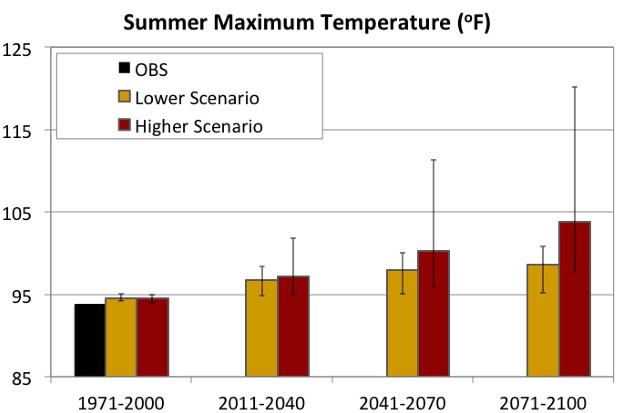
Experts predict higher summer temperatures in our area in future decades.
Change is Coming
Climate experts predict there will be significant changes in our area for the foreseeable future. The City of Austin partnered with the United States Department of Agriculture (USDA) Climate Hubs in 2020 to assess the vulnerability of Austin’s urban forests and natural areas to climate change. The USDA report warns we will see increases in temperature of five to ten degrees Fahrenheit over the next century. Rainfall patterns may vary seasonally from what we historically have expected. As a result, our favorite plants may struggle to survive. We will probably see a change in the hardiness zone for our region. Some tree species will be better able to adapt to these changes than others.
City land managers are already taking climate changes into account in their decisions. Often, this involves large projects with big budgets. For people who want to help but don’t have resources for major projects, there are some simple steps to apply. Below are some ideas we can all use in our own lawns and neighborhoods. If we work together, future generations of Austinites will be able to enjoy the continuing benefits of a healthy urban forest.
What can we do?
There are simple ways to help preserve our urban forest that don’t require a huge effort or expense. These are things we already do, for the most part. The goal now is to be more aware and deliberate about doing them consistently. Changes to our climate should guide us as we manage existing sites and plan for new development. Below are some goals to consider, and some strategies that can help us reach them.
Increase diversity
We love to plant trees, but we need to be thoughtful about what species we choose. Diversity of species, lifespan, and mature size are all important. The species we choose should be native to the site or adaptable to the conditions there. Sometimes, we may have to guess how a given tree will respond to hotter, drier weather or how it can handle the type of soil where it is planted. Our goal as we move forward should be to try a range of species, even within the same site. This will increase our chances that at least some of the trees we plant will be successful over the long term.
Here are some ways to take diversity into account as we plant new trees and landscapes:
- Avoid planting the most common species nearby. If every tree in an area is the same species, we risk losing them all to one problem as stressful conditions become more prevalent. For example, some northern cities lined their streets with American elms, then lost them all to Dutch Elm Disease in the 1970s. They replanted with only ash trees. Then they lost all of these trees to Emerald Ash Borer in the early 2000s. Planting a diverse mix of species would allow us to avoid this same mistake. If an outbreak of disease or pests occurs, we can retain some tree benefits while we replace any lost or damaged specimens.
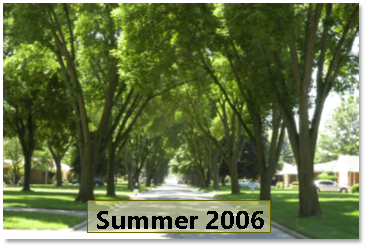
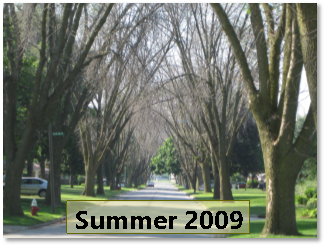
A street in Ohio was lined with healthy ash trees in 2006. In 2009, they were all killed by emerald ash borer. Photos by Daniel A. Herms, The Ohio State University.
- Choose new species from places where soil and other conditions are similar. A tree that thrives along the banks of a stream or river will probably struggle on a rocky hilltop. Species that have flourished in areas similar to your site conditions will have a good chance to survive there. Of course, with the hotter climate, they still might struggle. Look to hotter, drier places with the same soil type and conditions for species that can tolerate the changes. There is risk inherent in this strategy, unfortunately. The species we bring from other places could become invasive and crowd out the plants that historically have grown here. We will need to monitor results carefully and develop new species recommendations as we see how different trees perform.
- Create communities of plants instead of isolated specimens. Plants often form harmonious relationships together. For example, we often see landscapes with post oak, blackjack oak, and yaupon holly all growing in the same area. If we look at hotter climates with yaupon holly, we might find another species of tree that commonly grows near yaupon but isn’t common in Austin. We can develop these new communities locally in hopes that the new trees will perform well as our climate heats up.
Water during droughts
Trees are well adapted to storing resources to help them survive difficult conditions, but they have limits. Extended droughts take a heavy toll on trees. To avoid damage during long periods with no rain, it is important to give trees a long, slow soaking, even in yards with automatic sprinkler systems. The short, frequent intervals that keep grass looking good are not usually enough to help trees. Young trees might need additional water each week. Mature trees can usually get by with monthly irrigation, provided it soaks into the soil at least several inches deep. Adding a layer of mulch around trees helps retain moisture so we can water less often (see "Tree care" below).
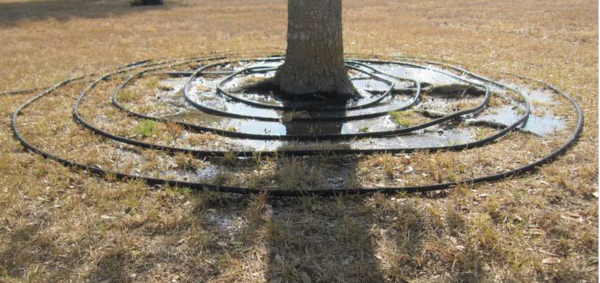
Soaker hoses can help trees survive drought conditions efficiently, especially when topped with mulch.
Keep your leaves in autumn
In a forest, the ground is covered with fallen leaves and other dead plant material. As it decays, it improves soil health and structure. When we remove all the leaves from a suburban lawn, our soil suffers. It’s good to rake leaves off turf grass, but keep them on your property. When raked underneath trees or shrubs, the leaves will blanket the soil and protect plants from extreme temperatures. If you are concerned they will blow back onto the grass, they can be composted in a bin or other container and used to feed the soil after they decompose.
Tree care
Planting new trees is great, but we must care for our existing trees to have a healthy urban forest. We can improve the health of most trees by protecting and improving their soil. A tree with healthy roots can better defend itself against pests, diseases, or environmental stress. This means we can avoid chemical applications that might damage sensitive ecosystems.
Adding compost to root zones twice a year improves the soil and helps roots thrive. Maintaining mulch beds under trees and other plants helps protect them against heat and drought while also improving soil. It can be hard work, but it’s inexpensive and requires only basic skills and equipment. It’s a good idea to test the soil in case other amendments are needed. A qualified arborist can explain the different options and their cost.
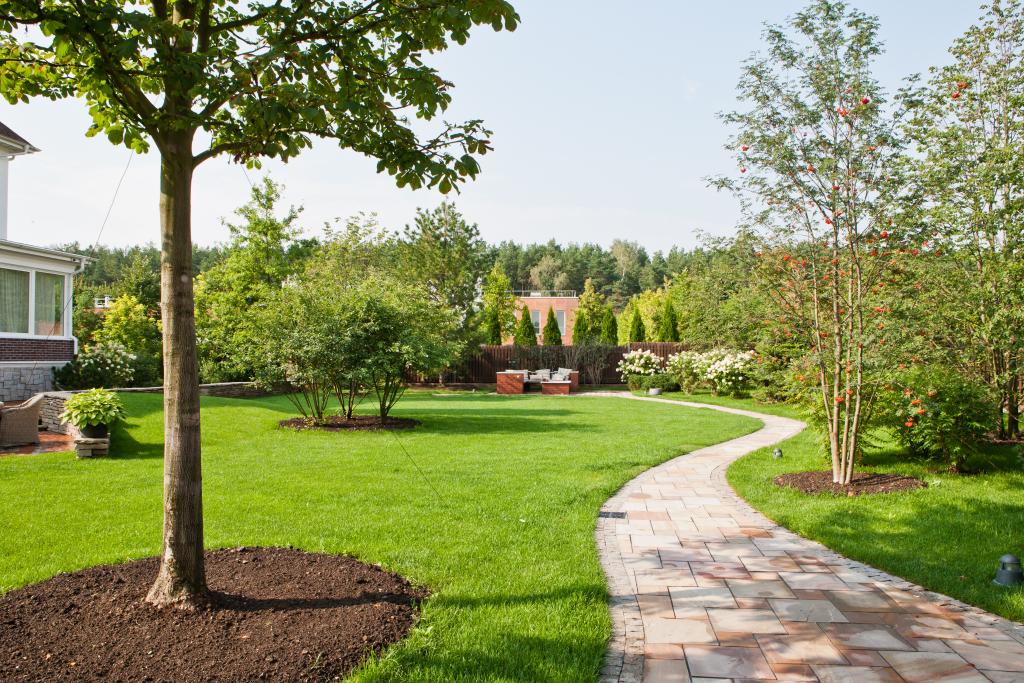
Even small mulch rings help protect trees against drought and temperature extremes.
Structural pruning
Why do some trees break in storms, while others come through them fine? We can never control every factor, but arborists have learned to identify warning signs that a tree is more likely to fail. Proper pruning while trees are young can reduce the chance they will break in old age. This saves tree canopy for shade and wildlife, reduces injuries to people and property damage, and provides significant benefits to our environment. Most young trees need up to 25 years of regular structural pruning to develop a strong, permanent structure.
A forest for the future
These are some simple ideas that can preserve our urban forest for future generations. If you would like to consider more ambitious projects, you can learn how at the USDA’s site. If we all remember to consider these strategies as we care for our homes and neighborhoods, future Austinites will have a healthy urban forest to enjoy for decades to come.
Article written by Keith Babberney, Education Forester for the Development Services Community Tree Preservation Division, City of Austin.
Visit the Tree Information Center at www.austintexas.gov/trees.


